Large Eddy Simulation of Yawed Wind Turbine Wake Deformation
Abstract
:1. Introduction
2. Numerical Methods
2.1. Governing Equations
2.2. Wind Turbine Model
2.3. Simulation Set-Up
3. Results and Discussion
3.1. Streamwise Velocity Fields and Turbulent Kinetic Energy
3.2. Wake Centerlines and Skew Angles According to Yaw Angles
4. Conclusions
Author Contributions
Funding
Institutional Review Board Statement
Informed Consent Statement
Data Availability Statement
Acknowledgments
Conflicts of Interest
References
- Mechali, M.; Barthelmie, R.; Frandsen, S.; Jensen, L.; Rethore, P.E. Wake effects at Horns Rev and their influence on energy production. EWEC 2006, 1, 10–20. [Google Scholar]
- Jiménez, Á.; Crespo, A.; Migoya, E. Application of a LES technique to characterize the wake deflection of a wind turbine in yaw. Wind Energy 2010, 13, 559–572. [Google Scholar] [CrossRef]
- Fleming, P.; Churchfield, M.; Scholbrock, A.; Clifton, A.; Schreck, S.; Johnson, K.; Wright, A.; Gebraad, P.; Annoni, J.; Naughton, B.; et al. Detailed field test of yaw-based wake steering. J. Phys. Conf. Ser. 2016, 753, 052003. [Google Scholar] [CrossRef]
- Fleming, P.; Annoni, J.; Scholbrock, A.; Quon, E.; Dana, S.; Schreck, S.; Raach, S.; Haizmann, F.; Schlipf, D. Full-scale field test of wake steering. J. Phys. Conf. Ser. 2017, 854, 012013. [Google Scholar] [CrossRef]
- Doekemeijer, B.M.; Kern, S.; Maturu, S.; Kanev, S.; Salbert, B.; Schreiber, J.; Campagnolo, F.; Bottasso, C.L.; Schuler, S.; Wilts, F.; et al. Field experiment for open-loop yaw-based wake steering at a commercial onshore wind farm in Italy. Wind Energy Sci. 2021, 6, 159–176. [Google Scholar] [CrossRef]
- Howland, M.F.; Bossuyt, J.; Martínez-Tossas, L.A.; Meyers, J.; Meneveau, C. Wake structure in actuator disk models of wind turbines in yaw under uniform inflow conditions. J. Renew. Sustain. Energy 2016, 8, 043301. [Google Scholar] [CrossRef]
- Bastankhah, M.; Porté-Agel, F. Experimental and theoretical study of wind turbine wakes in yawed conditions. J. Fluid Mech. 2016, 806, 506–541. [Google Scholar] [CrossRef]
- Shapiro, C.R.; Gayme, D.F.; Meneveau, C. Modelling yawed wind turbine wakes: A lifting line approach. J. Fluid Mech. 2018, 841, R1. [Google Scholar] [CrossRef]
- Shapiro, C.R.; Gayme, D.F.; Meneveau, C. Generation and decay of counter-rotating vortices downstream of yawed wind turbines in the atmospheric boundary layer. J. Fluid Mech. 2020, 903, R2. [Google Scholar] [CrossRef]
- Zong, H.; Porté-Agel, F. A point vortex transportation model for yawed wind turbine wakes. J. Fluid Mech. 2020, 890, A8. [Google Scholar] [CrossRef]
- Schottler, J.; Bartl, J.; Mühle, F.; Sætran, L.; Peinke, J.; Hölling, M. Wind tunnel experiments on wind turbine wakes in yaw: Redefining the wake width. Wind Energy Sci. 2018, 3, 257–273. [Google Scholar] [CrossRef]
- Kleusberg, E.; Schlatter, P.; Henningson, D.S. Parametric dependencies of the yawed wind-turbine wake development. Wind Energy 2020, 23, 1367–1380. [Google Scholar] [CrossRef]
- Hamilton, N.; Suk Kang, H.; Meneveau, C.; Bayoán Cal, R. Statistical analysis of kinetic energy entrainment in a model wind turbine array boundary layer. J. Renew. Sustain. Energy 2012, 4, 063105. [Google Scholar] [CrossRef]
- Lin, M.; Porté-Agel, F. Large-eddy simulation of yawed wind-turbine wakes: Comparisons with wind tunnel measurements and analytical wake models. Energies 2019, 12, 4574. [Google Scholar] [CrossRef]
- Bartl, J.; Mühle, F.; Schottler, J.; Sætran, L.; Peinke, J.; Adaramola, M.; Hölling, M. Wind tunnel experiments on wind turbine wakes in yaw: Effects of inflow turbulence and shear. Wind Energy Sci. 2018, 3, 329–343. [Google Scholar] [CrossRef]
- Hulsman, P.; Wosnik, M.; Petrović, V.; Hölling, M.; Kühn, M. Development of a curled wake of a yawed wind turbine under turbulent and sheared inflow. Wind Energy Sci. 2022, 7, 237–257. [Google Scholar] [CrossRef]
- Maronga, B.; Banzhaf, S.; Burmeister, C.; Esch, T.; Forkel, R.; Frohlich, D.; Fuka, V.; Gehrke, K.F.; Geletič, J.; Giersch, S.; et al. Overview of the PALM model system 6.0. Geosci. Model Dev. 2020, 13, 1335–1372. [Google Scholar] [CrossRef]
- Patrinos, A.N.A.; Kistler, A.L. A numerical study of the Chicago lake breeze. Bound.-Lay. Meteorol. 1977, 12, 93–123. [Google Scholar] [CrossRef]
- Deardorff, J.W. Stratocumulus-capped mixed layers derived from a three-dimensional model. Bound.-Lay. Meteorol. 1980, 18, 495–527. [Google Scholar] [CrossRef]
- Heinz, S. Realizability of dynamic subgrid-scale stress models via stochastic analysis. Monte Carlo Meth. Appl. 2008, 14, 311–329. [Google Scholar] [CrossRef]
- Mokhtarpoor, R.; Heinz, S. Dynamic large eddy simulation: Stability via realizability. Phys. Fluids 2017, 29, 105104. [Google Scholar] [CrossRef]
- Germano, M.; Piomelli, U.; Moin, P.; Cabot, W.H. A dynamic subgrid-scale eddy viscosity model. Phys. Fluids 1991, 3, 1760–1765. [Google Scholar] [CrossRef]
- Wicker, L.J.; Skamarock, W.C. Time-splitting methods for elastic models using forward time schemes. Mon. Weather Rev. 2002, 130, 2088–2097. [Google Scholar] [CrossRef]
- Wu, Y.T.; Porté-Agel, F. Large-eddy simulation of wind-turbine wakes: Evaluation of turbine parametrisations. Bound.-Layer Meteorol. 2011, 138, 345–366. [Google Scholar] [CrossRef]
- Jonkman, J.; Butterfield, S.; Musial, W.; Scott, G. Definition of a 5-MW Reference Wind Turbine for Offshore System Development; Technical Report NREL/TP-500-38060; National Renewable Energy Laboratory: Golden, CO, USA, 2009. [Google Scholar]
- Stevens, R.J.; Martínez-Tossas, L.A.; Meneveau, C. Comparison of wind farm large eddy simulations using actuator disk and actuator line models with wind tunnel experiments. Renew. Energy 2018, 116, 470–478. [Google Scholar] [CrossRef]
- Bastankhah, M.; Porté-Agel, F. Wind tunnel study of the wind turbine interaction with a boundary-layer flow: Upwind region, turbine performance, and wake region. Phys. Fluids 2017, 29, 065105. [Google Scholar] [CrossRef]
- Macrì, S.; Coupiac, O.; Girard, N.; Leroy, A.; Aubrun, S. Experimental analysis of the wake dynamics of a modelled wind turbine during yaw manoeuvres. J. Phys. Conf. Ser. 2018, 1037, 072035. [Google Scholar] [CrossRef]
- Wagenaar, J.W.; Machielse, L.; Schepers, J. Controlling wind in ECN’s scaled wind farm. In Proceedings of the EWEA 2012, Copenhagen, Denmark, 16–19 April 2012. [Google Scholar]
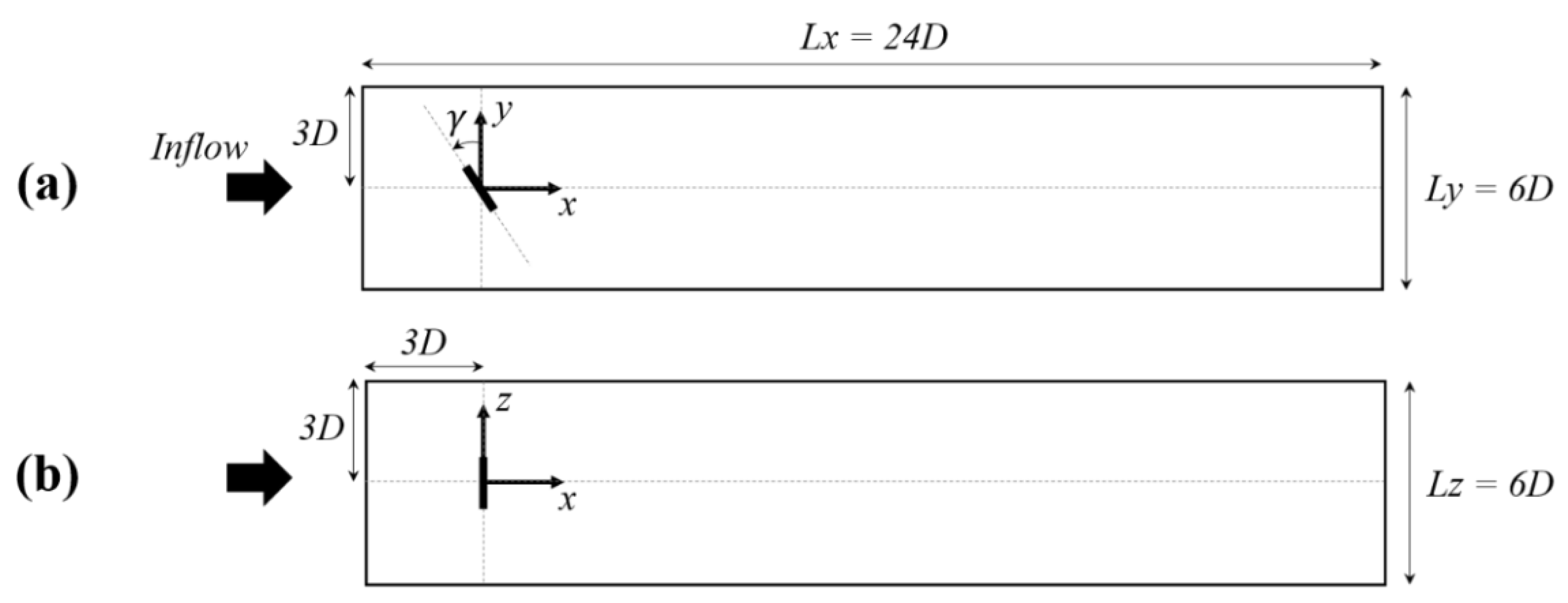
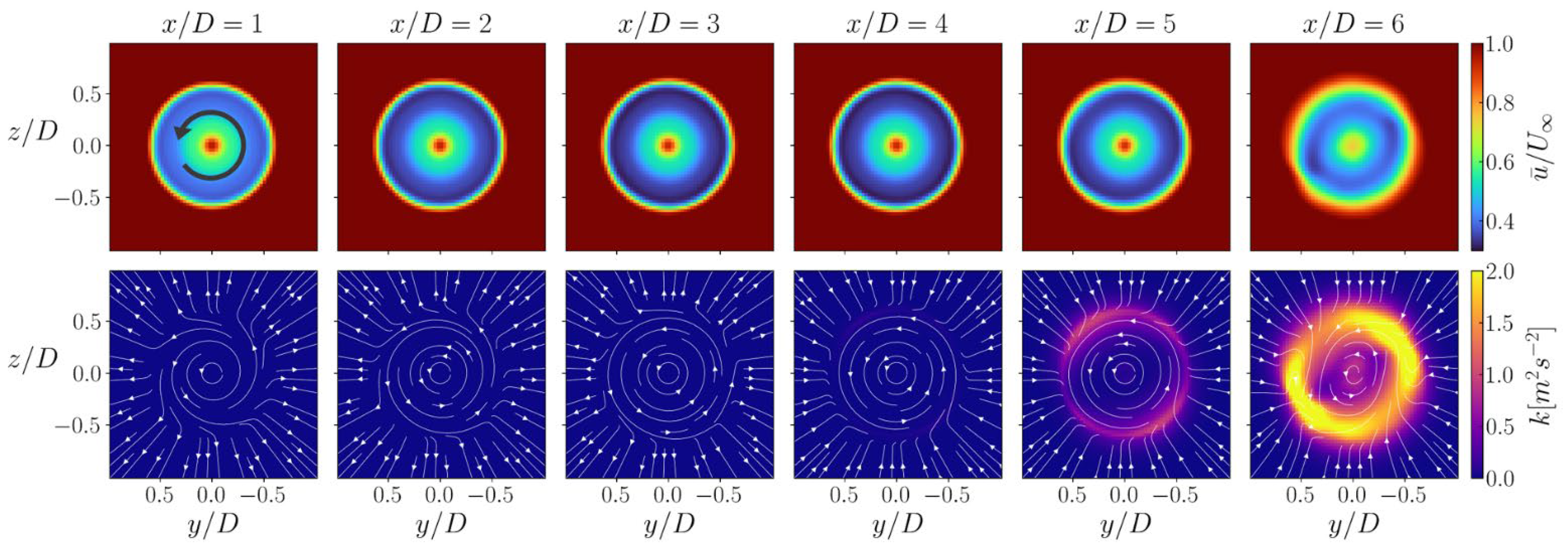

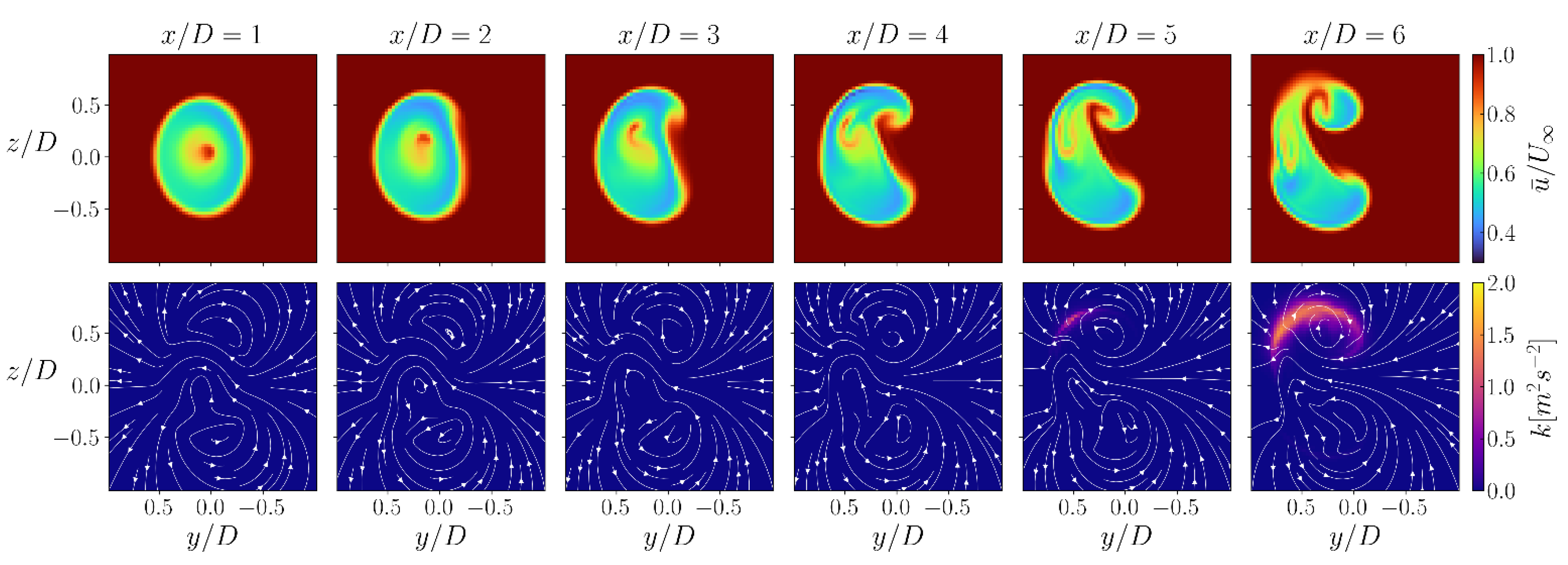
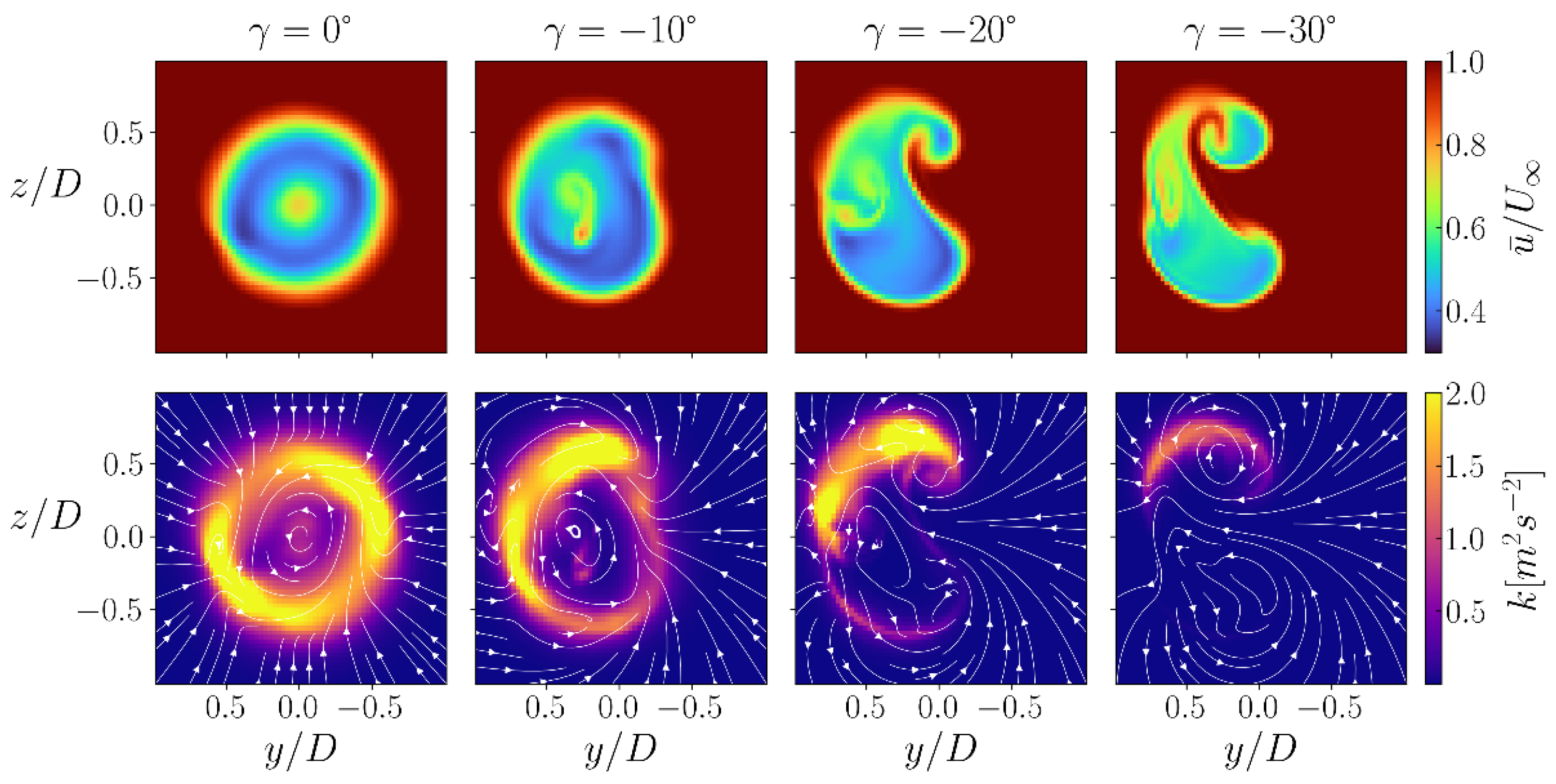

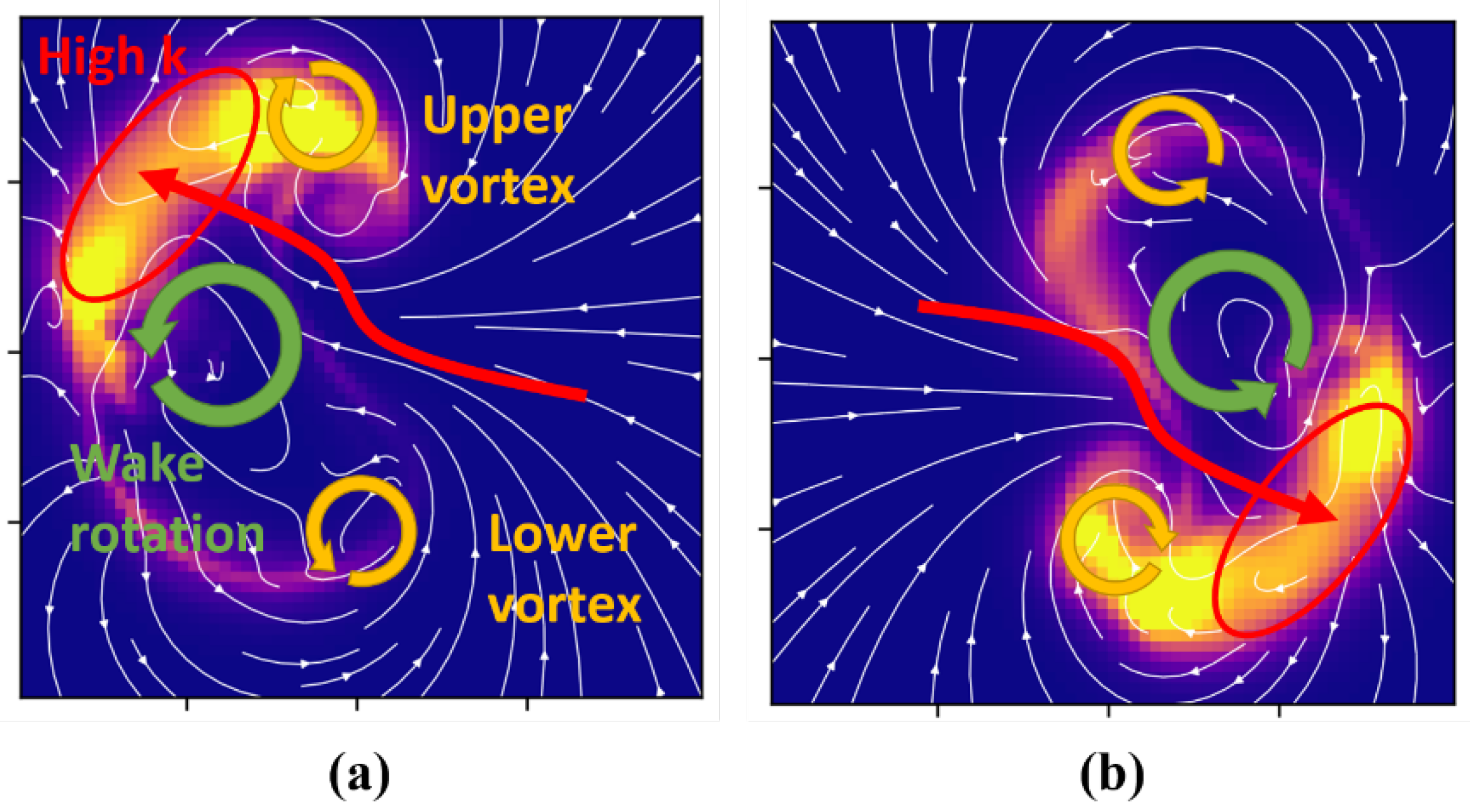
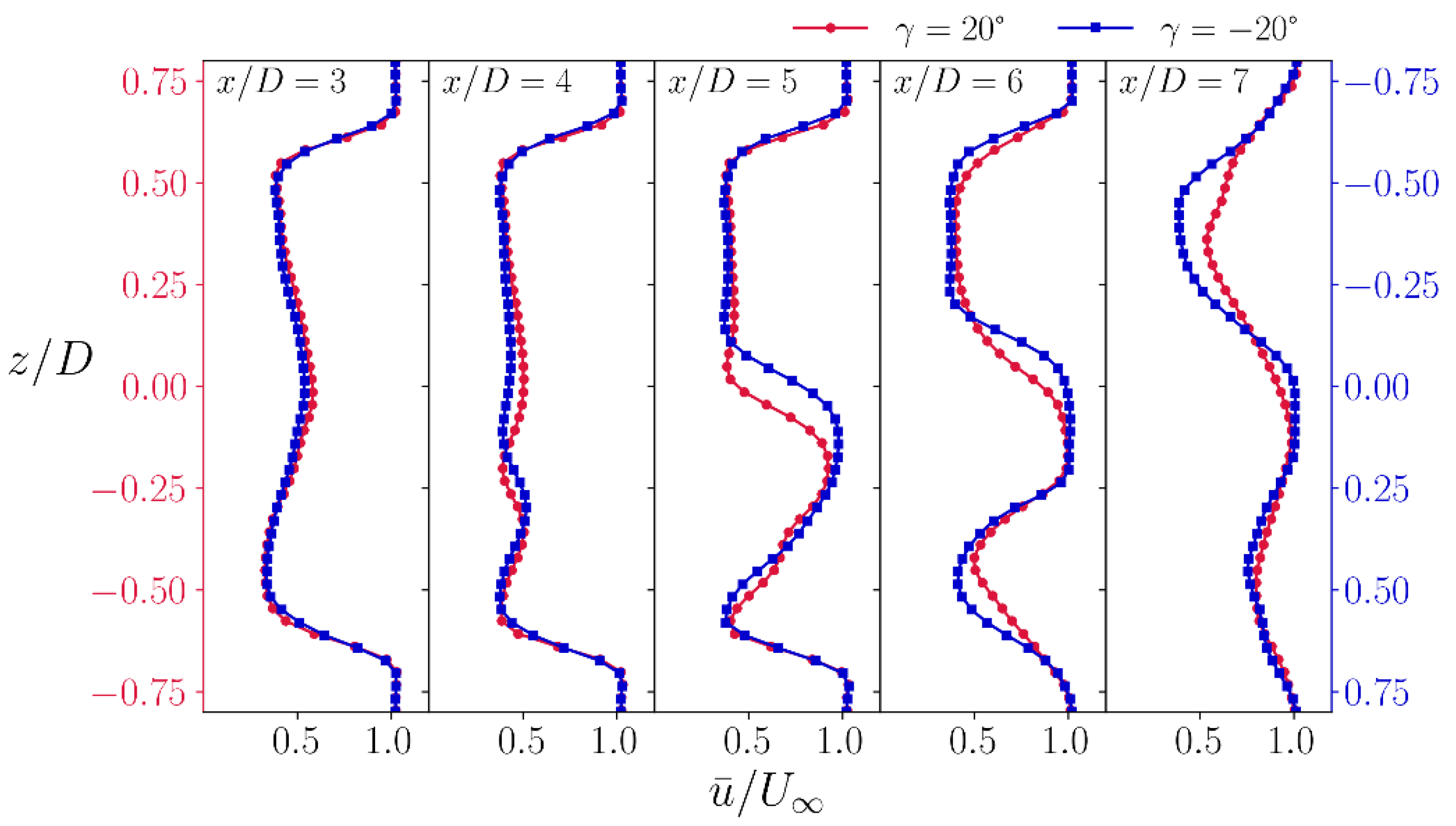
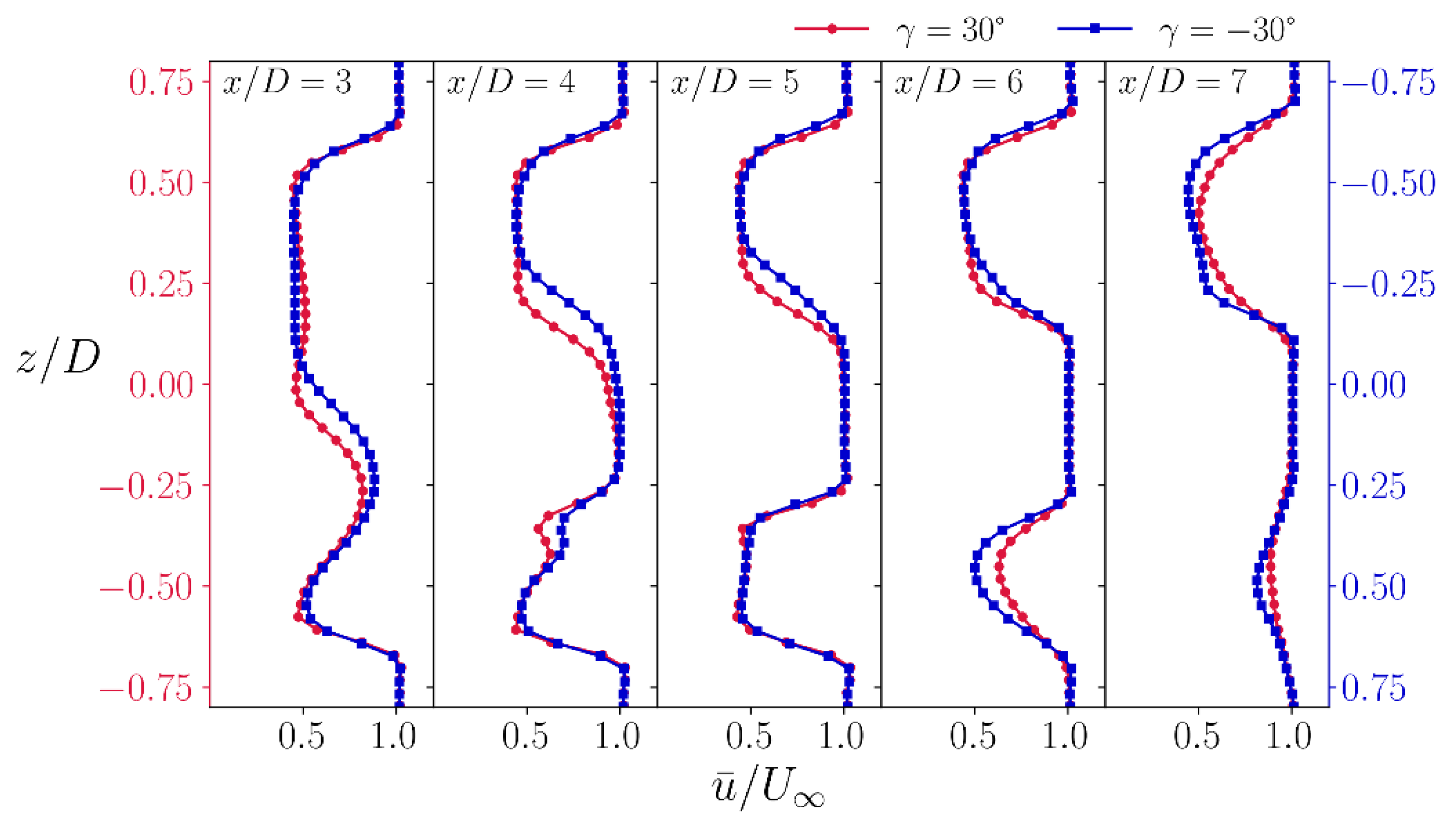

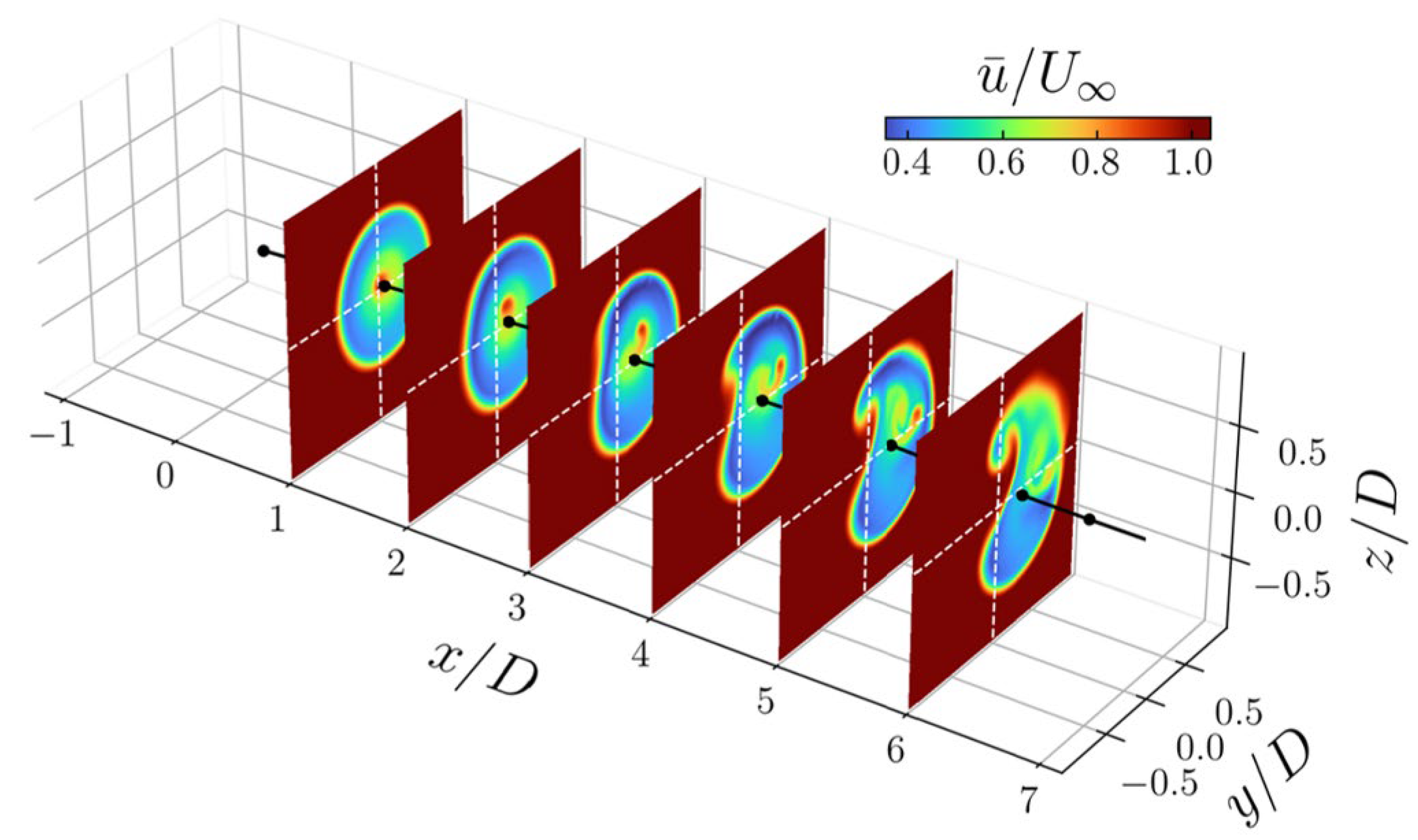
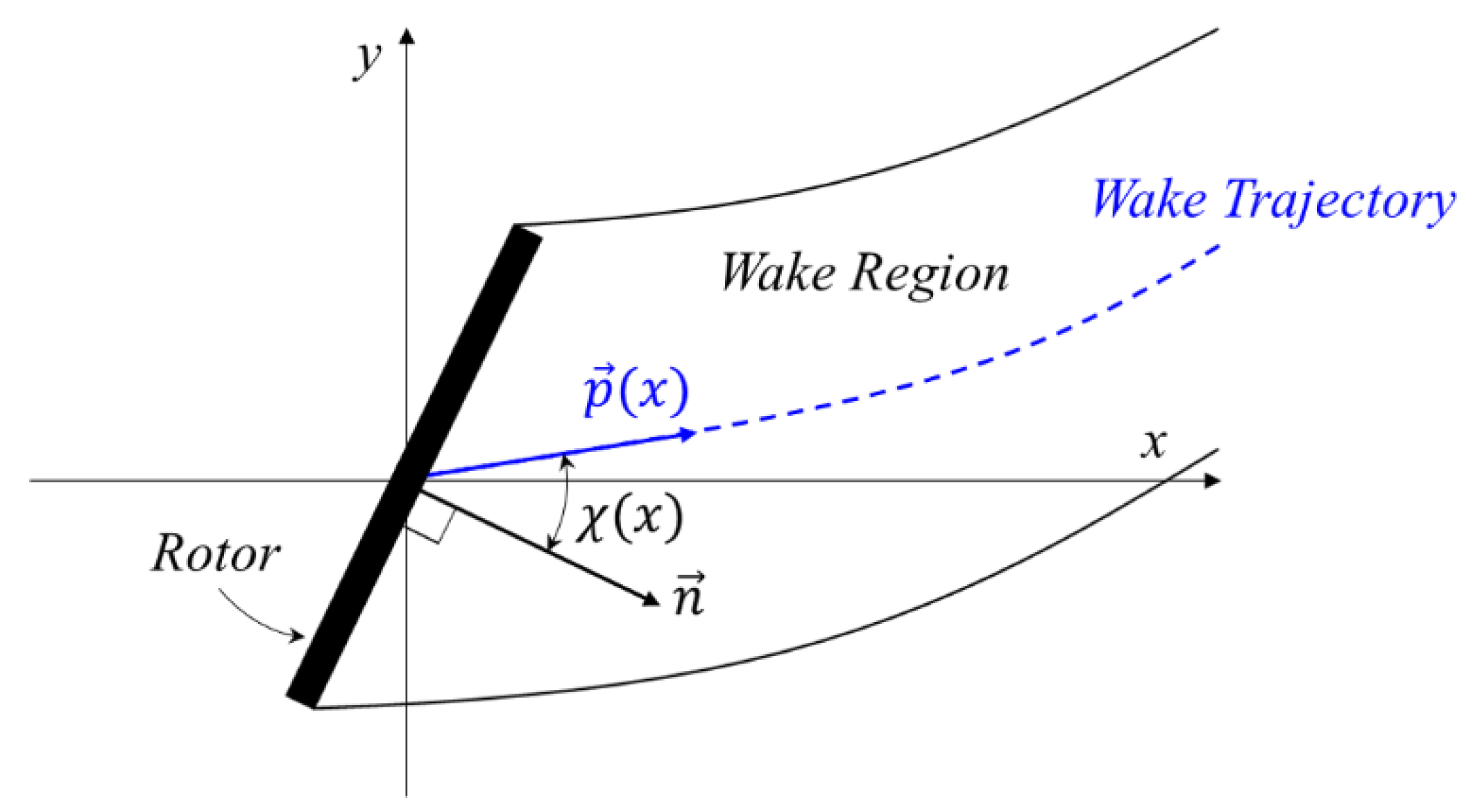

| Specification | Value |
|---|---|
| Rated power | 5 MW |
| Rotor orientation, configuration | Upwind, 3 blades |
| Rotor diameter | 126 m |
| Hub height | 90 m |
| Rated wind speed | 11.4 m/s |
| Rated rotor speed | 12.1 rpm |
| Inflow Wind Speed, [] | Yaw Angle, [] |
|---|---|
| 9 | −30, −20, −10, 0, 10, 20, 30 |
Publisher’s Note: MDPI stays neutral with regard to jurisdictional claims in published maps and institutional affiliations. |
© 2022 by the authors. Licensee MDPI, Basel, Switzerland. This article is an open access article distributed under the terms and conditions of the Creative Commons Attribution (CC BY) license (https://creativecommons.org/licenses/by/4.0/).
Share and Cite
Kim, H.; Lee, S. Large Eddy Simulation of Yawed Wind Turbine Wake Deformation. Energies 2022, 15, 6125. https://doi.org/10.3390/en15176125
Kim H, Lee S. Large Eddy Simulation of Yawed Wind Turbine Wake Deformation. Energies. 2022; 15(17):6125. https://doi.org/10.3390/en15176125
Chicago/Turabian StyleKim, Hyebin, and Sang Lee. 2022. "Large Eddy Simulation of Yawed Wind Turbine Wake Deformation" Energies 15, no. 17: 6125. https://doi.org/10.3390/en15176125
APA StyleKim, H., & Lee, S. (2022). Large Eddy Simulation of Yawed Wind Turbine Wake Deformation. Energies, 15(17), 6125. https://doi.org/10.3390/en15176125







